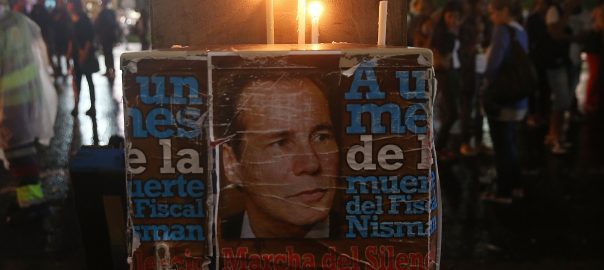For more than a decade, Alberto Nisman had been investigating the worst terrorist attack ever committed on Argentine soil: the 1994 bombing of the AMIA Jewish community center in Buenos Aires. Eighty-five people were killed and hundreds injured.
Four years ago this week, the federal prosecutor was putting the finishing touches on a report that would accuse then-President Cristina Fernandez de Kirchner and a dozen others of helping cover up the Islamic Republic of Iran’s responsibility for the attack.
On Jan. 18, the day before he was to present that report to Argentina’s congress, Mr. Nisman was found dead in the bathroom of his locked 13th floor apartment. A .22-caliber bullet had been fired at close-range into his head.
Who were those people? And from whom were they taking orders? Argentines attempting to answer such questions place themselves in danger.
Mrs. Kirchner initially called his death a suicide — even though his fingerprints were not found on the Bersa pistol left close to his body, and there was no gunpowder residue on his hands.
Just over a year ago, however, an investigation by 28 forensic experts and law enforcement officials conclusively determined that he did not kill himself. In fact, they were able to deduce, two people roughed him up, sedated him, and then shot him.
Who were those people? And from whom were they taking orders? Argentines attempting to answer such questions place themselves in danger.
Late last month, Federal Judge Sandra Arroyo Salgado, who also is Mr. Nisman’s former wife and the mother of their two daughters, withdrew from formal involvement in the investigation. The reason: ongoing threats — the “need to guarantee the protection and safety of the family,” as she phrased it in a written statement.
Mr. Nisman used wire-taped conversations to build his case against Mrs. Kirchner. Among them was one concerning an ally, former intelligence official Antonio Stiuso. Mrs. Kirchner says on tape: “We have to kill him.” Her defenders claim she did not intend to be taken literally. Mr. Stiuso, unconvinced, subsequently fled the country with his family.
In September 2017, former Argentine ambassador to Syria, Roberto Ahuad, revealed in testimony that Foreign Minister Hector Timerman had visited Syria in January 2011 to finalize an agreement with Iran, at a meeting hosted by Syrian dictator Bashar al-Assad. A message sent to Mr. Ahuad asked: “When are you committing suicide?” Another warned: “Beware of an induced suicide.”
And Eduardo Taiano, head prosecutor investigating Nisman’s murder, has received messages threatening to do to him and his son what was done to Mr. Nisman.
Nevertheless, Mr. Taiano is continuing to investigate, focusing most immediately on the calls made over more than 150 phone lines — many of them reportedly assigned to intelligence agents – on the day Mr. Nisman’s body was found.
Long before implicating Argentine officials in a conspiracy, Mr. Nisman had found solid evidence that officials of the Islamic Republic of Iran planned and financed the AMIA bombing, and that Hezbollah, its terrorist proxy, carried it out.
Mohsen Rabbani became cultural attaché at the Islamic Republic’s embassy in Buenos Aires just months before the AMIA bombing. In 1997, after Argentine authorities issued an arrest warrant for him, and INTERPOL a red notice (a request to locate and provisionally arrest an individual pending extradition), he managed to return to Tehran. Red notices for four other Iranian officials in connection with the bombing remain in place to this day.
Evidence points also to Hezbollah’s responsibility for the bombing of the Israeli embassy in Buenos Aires in 1992, in which 29 people were killed, and more than 200 injured. Argentine authorities charged Imad Mughniyah, the infamous senior Hezbollah operative, who also had been the mastermind behind the bombing of the U.S. Marine Barracks in Beirut in 1983. (He was killed in Damascus in 2008 in what may have been a joint Israeli/U.S. operation.)
The most likely motive for the AMIA attack: Iran’s rulers, in their own special way, were conveying displeasure over the Argentine government’s suspension of nuclear cooperation.
As for the cover-up, Mr. Nisman believed a deal was in the works to lift the red notices in exchange for oil.
Tehran and Hezbollah have long been seeking influence and power in Latin America, not least through illicit means. As far back as 2004, the U.S. Department of the Treasury designated Assad Ahmad Barakat, a Lebanese-born citizen of Paraguay, as a terrorist and Hezbollah financier. He and other members of his family are believed to have provided logistical support for both the AMIA and embassy bombings.
Recently, Argentina froze the assets of 14 members of the Barakat clan. That sent a message that Mauricio Macri, elected Argentina’s president in 2015, is unwilling to give Hezbollah free rein.
A few weeks ago, the U.S. State Department hosted a ministerial meeting with key Latin American officials that sent another message: Hezbollah operatives in the Western Hemisphere must be thwarted.
That said, it remains to be seen whether either Hezbollah or the Islamic Republic ever will be held to account for the terrorist attacks of 1992 and 1994, and whether anyone will be brought to justice for attempting to cover their tracks, and for the murder of the investigator who followed the facts wherever they led him.
That investigator, just days before he was assassinated, said prophetically: “With Nisman around or not, the evidence is there.” Argentines now face a choice: to act on that evidence, or to surrender to terrorists and murderers. To put it another way, they must decide what kind of nation Argentina is, and what kind of nation Argentina will become.
Read the full op-ed for The Washington Times here.
Clifford D. May is president of the Foundation for Defense of Democracies (FDD) and a columnist for the Washington Times. Toby Dershowitz is FDD senior vice president for government relations and strategy. Follow them on twitter at @CliffordDMay and @tobydersh.
